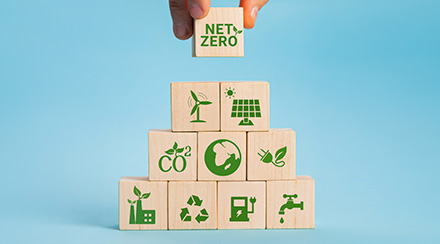What Are Carbon Offsets?
Individuals who are looking for ways to help the environment have no shortage of opportunities – recycling, making energy efficient home improvements, switching to electric vehicles, buying waste-free products, eating locally grown and raised foods – it all contributes to the health of our planet. But there is one more way to improve environmental quality: offsetting your own carbon footprint by investing in carbon offsets.
What Is a Carbon Offset?

The term “carbon offsets” is often used to refer to any effort to reduce greenhouse gas emissions or increase the amount of available carbon storage, both of which help mitigate the effects of climate change. But in the technical sense, a carbon offset is actually a certificate that represents the reduction of one metric ton of carbon dioxide emissions. When individuals and companies purchase these certificates, two things are accomplished: tangible efforts to reduce greenhouse gas emissions are funded, and the purchasers get to claim a net reduction or elimination of their carbon footprint by offsetting the amount of carbon they produce.
Examples of Carbon Offsets
Carbon offset certificates all have equal value – each one represents the reduction of one metric ton of carbon emissions. But the projects that are funded with the purchase of these certificates can vary quite a bit. Here are some common examples of carbon reduction efforts:
- Reforestation: Many carbon offset dollars go toward the planting of new trees, which help absorb carbon emissions. Because young trees don’t reduce as much carbon as mature trees, some efforts are more focused on preserving rainforests and other densely forested areas. Both of these efforts bring other environmental benefits, too, like increasing biodiversity and creating or preserving wildlife habitats.
- Renewable energy: Every time we expand our capacity for solar and wind energy, we reduce our dependence on coal and natural gas, which release carbon emissions into the atmosphere. Some carbon offsets go toward the installation of new renewable energy facilities.
- Greenhouse gas recapture: While carbon is the most plentiful greenhouse gas, it’s not the most harmful to the environment. Other gases, specifically methane, trap much more heat in our atmosphere. The technology to recapture gases like methane is always improving; it’s currently used in places like landfills, where rotting garbage produces methane, and dairy farms, where methane is emitted by cows and their manure. This recaptured gas can then be used for electricity or heat.
- Small-scale projects: Carbon offsets can also be used to fund smaller projects that reduce emissions, often in the developing world. These may include efforts to install low-smoke cookstoves and establish clean water programs designed to reduce the need to burn wood for boiling and sanitizing water. Programs like these not only help reduce emissions from smoke, they reduce the need for firewood, saving more trees.
How Are Carbon Offsets Calculated?

Buying and transferring carbon offset certificates is fairly simple because each certificate represents the reduction of one metric ton of carbon emissions. But in order for companies and individuals to be able to claim to be carbon neutral, they must calculate their own carbon emissions so they know how many offsets to buy. And in order for carbon-reducing projects to qualify for carbon offset certificates, they must also be able to prove how much carbon their projects will eliminate.
These calculations tend to be complicated, requiring the help of specialists and advanced technology. And they’re getting better all the time – for example, the technology used in evaluating the carbon elimination potential of forestry once produced inconsistent results, but newer advances have made it much more accurate.
To get an idea of how much carbon your household produces, you can use an online carbon calculator to estimate the total. These detailed calculators can also give you a better idea of which everyday activities release carbon emissions.
What Is a Carbon Credit?
Alongside carbon offsets, which represent a reduction in carbon emissions, there is another environmental instrument called a carbon credit, which represents the right to emit carbon. Carbon credits are typically used in cap-and-trade systems in which the government places a limit on the amount of carbon a company or entity can produce. If a company emits less carbon than is allowed under the cap-and-trade system, it can sell its excess carbon credits to another company. And if a company emits more carbon than is allowed, it must buy carbon credits from another credit holder.
These are complicated and expensive transactions, but most of us will never have to deal with them. Smaller companies and individuals who want to go carbon neutral will find it simpler and more affordable to stick with carbon offsets.
What Is a Renewable Energy Credit?
Another similar instrument is the renewable energy credit. These work much like carbon offsets, except instead of representing a reduction in carbon emissions, they represent the addition of renewable energy generation through technologies like solar power and wind power. Renewable energy credits represent a certain amount of renewable energy production measured in kilowatt-hours (kWh), and can be purchased and traded just like carbon offsets as a way to reduce our dependence on energy generated from fossil fuels.
Looking for Something Specific?
Select a category to find resources for topics that interest you.
Select Category

Related Articles:

What Is Renewable Energy, or Clean Energy?
It’s easy to think of renewable energy as cutting edge; we often associate it with solar panels and wind farms, and consider it to be the future of energy production. But this is only partially true.
Read Article
What is a Carbon Footprint and How to Reduce It
We all know some basic steps we can take to safeguard the environment, but some of the most significant changes we can make involve the way we use energy at home.
Read Article
What Is Wind Energy?
From windmills to modern wind turbines, we've been using technology to harness the power of wind for centuries. Learn how wind energy works today and the advantages and disadvantages of this type of renewable energy.
Read ArticleWhat Are Carbon Offsets?
Individuals who are looking for ways to help the environment have no shortage of opportunities – recycling, making energy efficient home improvements, switching to electric vehicles, buying waste-free products, eating locally grown and raised foods – it all contributes to the health of our planet. But there is one more way to improve environmental quality: offsetting your own carbon footprint by investing in carbon offsets.
What Is a Carbon Offset?
The term “carbon offsets” is often used to refer to any effort to reduce greenhouse gas emissions or increase the amount of available carbon storage, both of which help mitigate the effects of climate change. But in the technical sense, a carbon offset is actually a certificate that represents the reduction of one metric ton of carbon dioxide emissions. When individuals and companies purchase these certificates, two things are accomplished: tangible efforts to reduce greenhouse gas emissions are funded, and the purchasers get to claim a net reduction or elimination of their carbon footprint by offsetting the amount of carbon they produce.
Examples of Carbon Offsets
Carbon offset certificates all have equal value – each one represents the reduction of one metric ton of carbon emissions. But the projects that are funded with the purchase of these certificates can vary quite a bit. Here are some common examples of carbon reduction efforts:
- Reforestation: Many carbon offset dollars go toward the planting of new trees, which help absorb carbon emissions. Because young trees don’t reduce as much carbon as mature trees, some efforts are more focused on preserving rainforests and other densely forested areas. Both of these efforts bring other environmental benefits, too, like increasing biodiversity and creating or preserving wildlife habitats.
- Renewable energy: Every time we expand our capacity for solar and wind energy, we reduce our dependence on coal and natural gas, which release carbon emissions into the atmosphere. Some carbon offsets go toward the installation of new renewable energy facilities.
- Greenhouse gas recapture: While carbon is the most plentiful greenhouse gas, it’s not the most harmful to the environment. Other gases, specifically methane, trap much more heat in our atmosphere. The technology to recapture gases like methane is always improving; it’s currently used in places like landfills, where rotting garbage produces methane, and dairy farms, where methane is emitted by cows and their manure. This recaptured gas can then be used for electricity or heat.
- Small-scale projects: Carbon offsets can also be used to fund smaller projects that reduce emissions, often in the developing world. These may include efforts to install low-smoke cookstoves and establish clean water programs designed to reduce the need to burn wood for boiling and sanitizing water. Programs like these not only help reduce emissions from smoke, they reduce the need for firewood, saving more trees.
How Are Carbon Offsets Calculated?
Buying and transferring carbon offset certificates is fairly simple because each certificate represents the reduction of one metric ton of carbon emissions. But in order for companies and individuals to be able to claim to be carbon neutral, they must calculate their own carbon emissions so they know how many offsets to buy. And in order for carbon-reducing projects to qualify for carbon offset certificates, they must also be able to prove how much carbon their projects will eliminate.
These calculations tend to be complicated, requiring the help of specialists and advanced technology. And they’re getting better all the time – for example, the technology used in evaluating the carbon elimination potential of forestry once produced inconsistent results, but newer advances have made it much more accurate.
To get an idea of how much carbon your household produces, you can use an online carbon calculator to estimate the total. These detailed calculators can also give you a better idea of which everyday activities release carbon emissions.
What Is a Carbon Credit?
Alongside carbon offsets, which represent a reduction in carbon emissions, there is another environmental instrument called a carbon credit, which represents the right to emit carbon. Carbon credits are typically used in cap-and-trade systems in which the government places a limit on the amount of carbon a company or entity can produce. If a company emits less carbon than is allowed under the cap-and-trade system, it can sell its excess carbon credits to another company. And if a company emits more carbon than is allowed, it must buy carbon credits from another credit holder.
These are complicated and expensive transactions, but most of us will never have to deal with them. Smaller companies and individuals who want to go carbon neutral will find it simpler and more affordable to stick with carbon offsets.
What Is a Renewable Energy Credit?
Another similar instrument is the renewable energy credit. These work much like carbon offsets, except instead of representing a reduction in carbon emissions, they represent the addition of renewable energy generation through technologies like solar power and wind power. Renewable energy credits represent a certain amount of renewable energy production measured in kilowatt-hours (kWh), and can be purchased and traded just like carbon offsets as a way to reduce our dependence on energy generated from fossil fuels.
Looking for Something Specific?
Select a category to find resources for topics that interest you.
Select Category

Related Articles:

What Is Renewable Energy, or Clean Energy?
It’s easy to think of renewable energy as cutting edge; we often associate it with solar panels and wind farms, and consider it to be the future of energy production. But this is only partially true.
Read Article
What is a Carbon Footprint and How to Reduce It
We all know some basic steps we can take to safeguard the environment, but some of the most significant changes we can make involve the way we use energy at home.
Read Article
What Is Wind Energy?
From windmills to modern wind turbines, we've been using technology to harness the power of wind for centuries. Learn how wind energy works today and the advantages and disadvantages of this type of renewable energy.
Read Article






